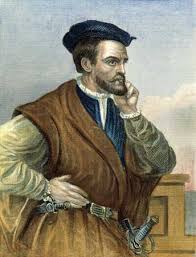 A French explorer Jacques Cartier was born in 1491 at the seaport of Saint Malo, on the extreme North east coast of Brittany France. The experience that Jacques had to become an explorer was that he studied navigation in Dieppe which was the major center for navigators in French. And as he studied he became a highly respected navigator. As a respectable mariner, he improved his social status in 1520 by marrying Mary Catherine des Granches, a member of a leading family. Also Cartier’s eye for detail and his natural curiosity allowed him to leave behind a very useful historical record. It is said that Cartier took 3 voyages.
A French explorer Jacques Cartier was born in 1491 at the seaport of Saint Malo, on the extreme North east coast of Brittany France. The experience that Jacques had to become an explorer was that he studied navigation in Dieppe which was the major center for navigators in French. And as he studied he became a highly respected navigator. As a respectable mariner, he improved his social status in 1520 by marrying Mary Catherine des Granches, a member of a leading family. Also Cartier’s eye for detail and his natural curiosity allowed him to leave behind a very useful historical record. It is said that Cartier took 3 voyages.
The first voyage took place in 1531. It was when Francis I ordered Cartier to look for the Northwest Passage, which was the short route to the Pacific Ocean. That time Cartier got two small ships and 61 crew members. He left Saint Malo in April. But then less than three weeks, he was sailing down the coast of Newfoundland. There, he discovered the Magdalen and Prince Edward islands. Cartier’s crew then crossed the Gaspe Peninsula and took control of it for France before returning to saint Malo. But unluckily he mistakes the mouth of the St. Lawrence River for a bay, and failed to look into it. Cartier’s picture of the remote land energized many young explorers to seek their life in the New World.
His second mission or journey was in 1535 where the king sent him out again. This time he sailed up the St. Lawrence River and documented it for what it was. He continued on, finding Mont Real which is now Montreal, Canada. The crew spent the winter at an Indian village near Stada Cona, Quebec, where Cartier watched 25 of his men die of scurvy. Scurvy is a disease from a lack of vitamin C. The Huron is a member of an Indian tribe, living west of Lake Huron, and they were kind to Cartier. But he betrayed them and kidnapped 12 Indians, including their chief, and headed straight for France. The reason he did this was because he hoped that his prisoners would tell him where their gold mine was located, but there really was no gold mine.
And finally his 3rd trip, which was his last, was in 1541. His third journey was put together to help Jean Roberval find a colony in Canada. Roberval was failing to find enough French colonists and was also willing to give up the advantages of home for the uncivilized New World. So Roberval asked his government to help. His needs were complete by freeing people from prison that was willing to join the expedition. While Cartier went ahead, Roberval awaited his people. In June 1544, Roberval got there on a supply ship and found out that Cartier had gone back to France. Cartier had left Roberval stuck and abandoned in New France with a gathering of robbers and murderers. Although Cartier never found the Northwest Passage, his explorations served as a basis for the French claims in the rich St. Lawrence Valley. Also led to many future expeditions by France to Canada. Cartier died in 1555 with a life span of 64 years.